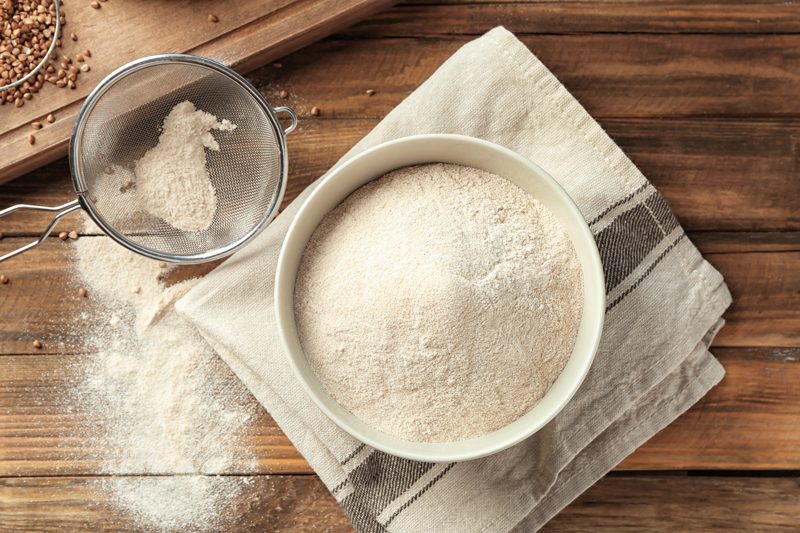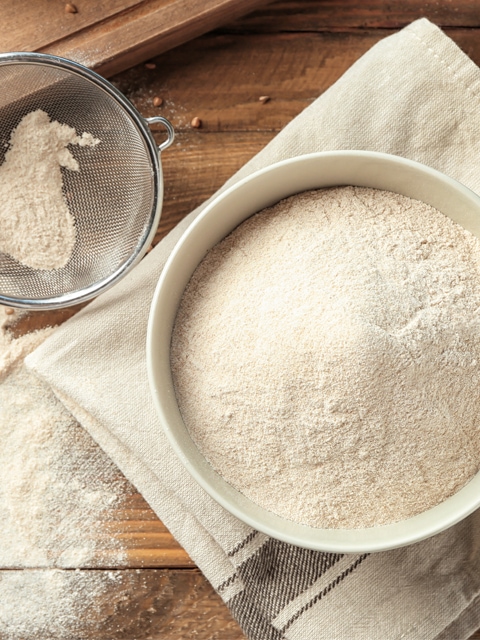
Contrary to what its name indicates, buckwheat is not a form of wheat. It’s not even a relative to the wheat family. Buckwheat is gluten-free, a good source of protein, contains eight essential amino acids. To read about all the incredible health benefits of buckwheat, check out this site. Today, we are going to learn how to make our own buckwheat flour.

Here is an inspiring story of how a little raw buckwheat sprouted up to be a nutrient-dense flower flour… The story began with 1 cup dry raw buckwheat, and after a short little home-spa soaking treatment, it began to sprout. But lost in the bliss of a day of pampering, it started to retain a little water, as it expanded to robust 2 1/3 cups buckwheat!
The poor little buckwheat decided to lay out in the heat to see if it could shed some of this water weight. It spread itself out in the dehydrator, and after about 4-6 hours of a 115 degrees (F) heat, it reduced itself back to 1 1/4 cups of dehydrated buckwheat. Life comes full circle with that 1 cup of dry raw buckwheat… because after blitzing it to a flour, we are back to the volume of 1 cup flour!
Ok, ok, all silliness put aside… Raw buckwheat flour is a wonderful staple to have ready in your “pantry.” If you are ever in need of a slightly nutty-tasting flour that is silky in texture… this is a great one to use. By sprouting the buckwheat first, it will increase their nutritional properties and digestibility. Out of all the homemade flours that I make, buckwheat is the finest in texture.
Keep in mind that the measurements I provide below are just for basic guidelines. Feel free to use more or less, depends on how much you want to make.
 Ingredients:
Ingredients:4 cups dried groats = 3 1/2 cups of flour
Hi Amie Sue. Thanks for the information. What do you think the flour is best for? Would you recommend using it for cakes for example. By the way this continues to be a fantastic website and resource. It is definitely my favourite amongst the raw food sites. All the best, Amanda
Good morning Amanda… I use buckwheat flour in my raw recipes; breads, crackers and some cookies. It can replace nut flours if a person has nut allergies too. I am happy to hear that you are enjoying the site. I just love sharing all that I do in the kitchen. Have a great day! amie sue
Hello again!
Can I always use buckwheat flour in place of nut flours? It would open up a whole new world for me if I could.
I struggle with the fibres in nuts and seeds as I have diverticulitis but buckwheat and oats are great. I consume nut and seed milks but strain them religiously. I am fine with shelled sesame and hemp hearts and coconut too. But buckwheat is a staple for me – in all forms. Flours from shelled seeds tend to go off quickly so aren’t as practical as buckwheat flour.
I read another commentator who said she had a similar gut condition and I should have written some comments to her but forgot. I’ve had it for decades.
Intolerance to nut and seed fibres is common in these conditions as the fibres get caught up in the gut. Mulcilaginous seeds like chia and well soaked flax are exceptions.
Soaked chia actually helps the digestive process as well as being nourishing. Forget over the counter fibres – we are blessed to have cheap and cheery chia seeds.
I love your chia recipes. I’ve done endless versions of you chia jam. I’ve also done it with soaked dried fruits which is really economical.
You are a marvel
Xx
Hello Helen,
To answer your question as to whether or not you can use buckwheat in place of nut flours… I have to say that it’s possible but can’t always guarantee the recipe outcome. Buckwheat is much drier and has less healthy fats. I find that I use buckwheat as my base, it is ry on my pallet. Maybe that is just me. You can always experiment and see for yourself. :)
I love chia seeds to. I am glad that the don’t cause you issues. Thanks for sharing your experience Helen. It will help others who come after this. :) Blessings and enjoy your day! amie sue
I had thought the same about the flours……nut flours are a lot out more substantial aren’t they….as you say, probably because of the fats. Buckwheat flour is so light, fine and airy too. Maybe I’ll leave the experimenting to you, and stick to the recipes exactly until I’m better at food preparation (in my dreams…..).
Thank you so much for your help and inspiration.
Reading questions and answers from other followers is such a fantastic learning experience. Thank you for providing such an informative, free and well balanced platform for us. I think we all appreciate it tremendously.
Amie
I’m confused….. I have buckwheat groats from Bob Redmill, is this what I use? And if yes how do I Sprout?
Hey Maureen,
I had provided a link in the ingredient list that will tell you how to sprout buckwheat, so be sure to check that out. Also, I am not sure what type of buckwheat groats you have from Bob’s Redmill. They come in two different forms; raw buckwheat or kasha (buckwheat groats which have first been roasted before selling). In order to sprout them, they need to be RAW. Raw buckwheat is light tan in color whereas kasha is dark brown. I hope that helps, amie sue
I love making my own buckwheat flour – I found it helpful to freeze the sprouted/dehydrated buckwheat in a glas jar- whenever you are ready, you can grind into flour and store that in freezer too. The grains grind easier when frozen and less likely to reach a high temperature, rendering them not raw. They get pretty hot when being ground. I took temp a few times and realized that I ruined a few batches…putting your vitamix container in the freezer for an hour or so can help a little too.
OH gosh Babs…. my flour never even gets warm when I grind it in my Vitamix dry container. I don’t fill the container so maybe that is why. Thanks for sharing what you do though. Have a great day, amie sue
Hello ! I would like to make this for my birthday that is coming up. My question is what can i use instead of the buckwheat flour ? Coconut flour and or ?
Aloha for your time !
Happy Birthday Carmen :) What would you like to make for your birthday? You posted your comment under buckwheat flour… is that what you want to make? :)
Hi Amie-Sue, Oops. I was looking to make your Carrot Cake with pumpkin spice frosting. But i did not want to use buckwheat flour. i don’t have time to sprout .
Aloha, :)
Hello Carmen,
You ca just about use any other flour… always keep in mind what texture and overall flavor that it will add to the recipe. It will be different but there is nothing wrong with different. :) I just wouldn’t recommend store bought coconut flour as it is too drying and will suck the moisture out the of cake. I hope you have a blessed birthday celebration! amie sue
I notice someone asked about store bought buckwheat flour…but I didn’t get a clear sense of if that would work or not, if we don’t have time to sprout?
Good morning Mary,
Store bought buckwheat flour will work, just keep in mind that it isn’t raw and most of the nutrients has most likely been stripped of it. It is always best to soak, sprout, dry, and grind your own. It’s a process no doubt, but it all depends on where you are in your journey when it comes to eating healthy. I hope that helps. Blessings and Happy Thanksgiving. amie sue
Greetings, Amie-Sue, brilliant website!
Is the Vitamix the best tool for making nut flour?
Have you ever worked with a Robot-coupe?
Can you recommend other commercial processors you for grinding larger quantities of nuts into flour?
Thank you for your time with this.
Good afternoon Molly,
I only use the vitamix, dry container for my nut/grain flours… but then that is all that I have. :) Guess I never felt the need to invest in any other appliance. As far as commercial sized ones go…good question but I don’t know what to recommend since I have tested anything else. Sorry that I am not much help. Blessings, amie sue
Hello,
Your website and the recipes are really very good. I am sure they taste wonderful. I would like to ask a question about buckwheat flour. I did not know that I should sprout buckwheat and instead I grinded the raw light green color buckwheat and used it to cook simple small breads by mixing salt, water and baking power right away. Before I had baked toasted buckwheat flour the same way. Is it something harmful to health? Why do you have to sprout first ? Is it for hygenic purposes ? Thanks in advance for your reply.
Hello Nalan,
You can read here (https://nouveauraw.com/sprouting/how-to-sprout-and-use-buckwheat-groats/) to read why I sprout buckwheat. I hope it helps. amie sue
Thank you for the quick response. Then I understand that sprouting makes it easier to digest. In other words sprouting is better for health but also I won’t be poisoned if I use raw bw flour directly in the bakery. The site is wonderful, perfect. Very succesful
Is it safe to consume raw buckwheat flour to be added to rice milk and whole rolled oats cold cereal? and is the buckwheat flour you buy already been soaked prior to making it into buckwheat flour?
Hello Robert,
Most likely the store bought buckwheat flour wasn’t sprouted before being made into flour. Depends on the source. Are you making your own? Soaking, sprouting, dehydrating it, then grinding to a flour? If you are doing this, then I would be a-o-k with adding it to a porridge with oats. Blessings, amie sue
I bought some Organic Raw Buckwheat Groats. Can I eat them out of the bag? They tasted great, but I read that you should soak first. Is that absolute necessity?
Hello M,
It is best to soak, rinse, and dehydrate them if you want to eat them straight as a snack. This will help reduce the phytic acid and make it easier on your digestion. They only require a 30 minutes soak. Blessings, amie sue
Hello, I do not have a dehydrator. How would you dehydrate using a Smeg electric oven.
B We have a setting for traditional convection or fan?
Hello Elizabeth. I am not familiar with this oven brand. I have a post called Conventional Oven Food Drying that might be of help – https://nouveauraw.com/reference-library/dehydrator-basics/conventional-oven-food-drying/
Blessings, amie sue
Hi Amie-Sue. This is very helpful. Thank you. :-) Is it possible to put a Print button on this page please? Many Thanks.